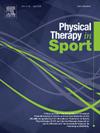Reliability of the Athletic Shoulder test in asymptomatic and symptomatic overhead racquet athletes
IF 2.2
3区 医学
Q1 REHABILITATION
引用次数: 0
Abstract
Objectives
Assessing intra- and inter-rater reliability of the Athletic Shoulder (ASH) test using a force plate in asymptomatic and symptomatic overhead racquet athletes.
Design
Within-session, intra- and inter-rater reliability.
Setting
Physiotherapy practice in Belgium.
Participants
Forty-two overhead racquet athletes (21 asymptomatic, 21 symptomatic with shoulder complaints), all playing tennis, badminton, and/or padel for at least 4 h weekly.
Main outcome measures
Intra- and inter-rater reliability (intraclass correlation coefficients), standard errors of measurement, minimum detectable change, and agreement (Bland-Altman plots).
Results
The ASH test demonstrated excellent intra-rater reliability among asymptomatic (ICC 0.93–0.98) and symptomatic athletes (ICC 0.91–0.98) in all positions (I,Y,T). Inter-rater reliability ranged from good to excellent (asymptomatic: ICC 0.80–0.95, symptomatic: ICC 0.79–0.91).
Conclusions
The ASH test demonstrated excellent reliability for single-rater use, supporting its utility for assessing isometric strength in overhead racquet athletes, with or without shoulder complaints. In the asymptomatic group, excellent inter-rater reliability was observed in the Y and T positions. In the symptomatic group, only the non-dominant T position showed excellent inter-rater reliability, making consistent use of a single rater preferable in this population. Future applications may aid injury rehabilitation and return-to-play protocols in sports medicine.
无症状和有症状的顶拍运动员肩部测试的可靠性
目的评估无症状和有症状的顶拍运动员使用力板进行运动肩(ASH)测试的内部和内部可靠性。设计会话内、内部和内部可靠性。比利时的物理治疗实践。参与者:42名顶拍运动员(21名无症状,21名有肩部不适症状),每周至少打4小时网球、羽毛球和/或板。主要结果测量指标:组内和组间信度(组内相关系数)、测量标准误差、最小可检测变化和一致性(Bland-Altman图)。结果无症状运动员(ICC 0.93-0.98)和有症状运动员(ICC 0.91-0.98)在所有体位(I,Y,T)上均表现出良好的量表内信度。评分者间信度从良好到极好(无症状:ICC 0.80-0.95,有症状:ICC 0.79-0.91)。结论ASH测试在单次使用中表现出极好的可靠性,支持其用于评估顶拍运动员的等距力量,无论有无肩部不适。在无症状组中,在Y和T位置观察到良好的评分间信度。在有症状组中,只有非显性T位显示出出色的评分者间可靠性,使得在该人群中一致使用单一评分者更为可取。未来的应用可能有助于运动医学的损伤康复和恢复比赛协议。
本文章由计算机程序翻译,如有差异,请以英文原文为准。
求助全文
约1分钟内获得全文
求助全文
来源期刊

Physical Therapy in Sport
医学-康复医学
CiteScore
4.50
自引率
8.30%
发文量
125
审稿时长
39 days
期刊介绍:
Physical Therapy in Sport is an international peer-reviewed journal that provides a forum for the publication of research and clinical practice material relevant to the healthcare professions involved in sports and exercise medicine, and rehabilitation. The journal publishes material that is indispensable for day-to-day practice and continuing professional development. Physical Therapy in Sport covers topics dealing with the diagnosis, treatment, and prevention of injuries, as well as more general areas of sports and exercise medicine and related sports science.
The journal publishes original research, case studies, reviews, masterclasses, papers on clinical approaches, and book reviews, as well as occasional reports from conferences. Papers are double-blind peer-reviewed by our international advisory board and other international experts, and submissions from a broad range of disciplines are actively encouraged.
 求助内容:
求助内容: 应助结果提醒方式:
应助结果提醒方式:


